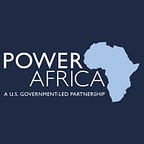Keeping Wildlife Safe and the Lights on Where Nature and Energy Infrastructure Meet in Southern Africa
Africa’s majestic animals and its evolving energy infrastructure are increasingly coming into contact. As electricity access is extended across the continent, Power Africa and the Endangered Wildlife Trust (EWT) are working together to minimize the danger to animals and the risks to energy utilities.
In the protected areas and national parks of sub-Saharan Africa, energy infrastructure, such as power lines, present protentional danger to wildlife. Large mammals like giraffes and elephants get electrocuted by power lines located too close to the ground and birds collide with transmission line conductors and wires. These dangerous interactions also damage energy infrastructure, leading to electricity interruptions and costly repairs for utilities.
To help reduce the threat to wildlife and protect energy infrastructure, Power Africa teamed up with EWT to develop mitigation measures that help utilities optimize performance through better management of wildlife and energy infrastructure interactions.
Changing the Way Utilities Think About and Manage Wildlife Interactions
The Mainstreaming Wildlife Incident Management into Utilities in Southern Africa manual developed in collaboration with EWT, details the variety and severity of wildlife interactions with energy infrastructure. The manual describes how to operate a wildlife management system (WMS) to monitor and mitigate wildlife collisions, reduce infrastructure damage and wildlife losses, and improve utilities’ quality of supply to customers.
This colorful, easy-to-read document provides classifications and examples of wildlife interactions, as well as clear, practical solutions to such incidents.
Power Africa and EWT presented the manual to the environmental, planning, and operating subcommittees of the Southern African Power Pool.
Leading by Example: Mozambique’s Power Utility Embraces Wildlife Management
Power Africa and EWT integrated a similar system into Mozambique’s state-owned power utility, Electricidade de Moçambique (EDM). EDM works to achieve the Government of Mozambique’s goal of electrifying all households by 2030. To meet this goal, EDM must construct new electricity infrastructure, reduce damage to existing power lines, and save costs.
In April 2021, EWT, Power Africa, and EDM initiated and assessment of the utility’s current capacity to manage wildlife incidents with the goal of transferring the best skills and tools to implement a WMS. Power Africa and EWT presented the readiness assessment findings to EDM’s board of directors, who expressed appreciation and excitement about the next steps: developing trackers and tools to implement a WMS, conducting training, and developing a WMS handbook tailor-made for EDM.
In November 2021, Power Africa and EWT completed a two-day WMS training for EDM, which focused on classifying and capturing incidents in a central database, identifying wildlife species, and implementing mitigation measures to improve system reliability, save money, and protect wildlife.
Belarmina Severiano Mirasse, Head of Quality at EDM’s Environmental Department, commented, “EDM appreciates Power Africa and EWT’s assistance. EWT demonstrated the financial and reputational impacts of wildlife and energy interactions, which has changed how we prepare for and conduct our business. EDM hopes to see visible changes in the near future as we integrate the WMS and the associated activities among all EDM staff.”
Zooming in on South Africa’s Protected Areas
A recent EWT study estimates that if all high-risk wooden distribution poles in the Kruger National Park alone were protected against large mammal impacts, the South African utility, Eskom, would save about $1.27 million (R18 million) annually.
With Power Africa support, EWT assisted Eskom by performing a desktop and field investigation, mapping all of the energy infrastructure in South Africa’s protected areas and ranking the areas from most to least affected by wildlife and energy infrastructure interactions.
Based on these rankings, EWT selected 10 protected areas in each province — for a total of 90 protected areas — to be ground-truthed (i.e., for these areas, facts found from maps, air photographs, or satellite images were checked on the ground). EWT assessed the energy infrastructure in these areas in terms of scale, voltages, structural design (wildlife-friendly vs. -unfriendly), current mitigation measures, and perceived risk based on species present in the area. By eliminating wildlife interactions in these potential hotspots, Eskom will reduce the loss of revenue due to wildlife incidents, improve the quality of supply across affected power feeders, and conserve critical biodiversity.
Achieving a Wildlife-Friendly Electricity Network
By leaning on EWT’s experience, Power Africa has spotlighted the importance of managing wildlife interactions with energy infrastructure in Southern Africa. If utilities begin documenting and addressing wildlife interactions, supplementing environmental impact assessment processes with internal due diligence, deploying wildlife-friendly designs, and installing mitigation products on hardware where appropriate, they will prevent countless wildlife mortalities, optimize network performance, and increase their profitability.
Resources:
- Mainstreaming Wildlife Incident Management into Utilities in Southern Africa
- Power Africa and EWT developed a similar manual for East African utilities. Download the Mainstreaming Wildlife Incident Management into Utilities in East Africa guide: https://pdf.usaid.gov/pdf_docs/PA00XX2C.pdf
